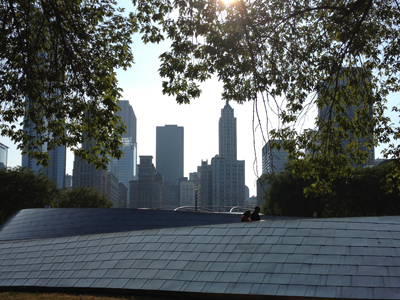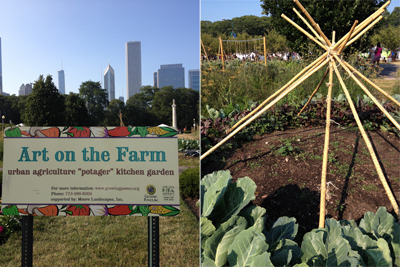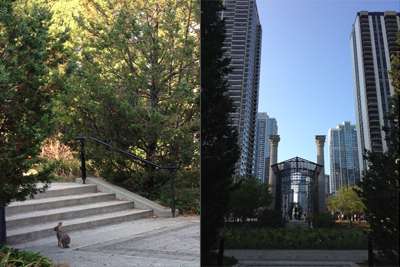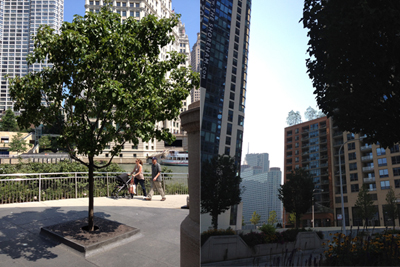We settle in at Hotel Felix near River North. From the 9th floor of the refinished mid-rise we catch glimpses of dramatic churches, blues clubs and the infamous downtown Loop - the above-ground rail line. We drop our things and make our way to Millennium Park down the Magnificent Mile, a stretch is known for its designer brands and wide sidewalks. I can't help but notice the garden beds and healthy street trees that line each side.

We stop at the giant bean (Cloud Gate by Anish Kapoor) and as we make our way through Grant Park, we're met by a giant crowd of hungry tourists - it's the taste of Chicago. My immediate urge is to eat deep dish pizza until I can't move. But against my better judgement, I grab just one slice. We find shade and admire the mature trees, winding paths, monuments, fountains and urban agriculture. My eyes find a full community garden and I fall in love.

The Potager, French for ornamental vegetable or kitchen garden, contains over 150 heritage and heirloom varieties of edible plants. But unlike other gardens of this nature that I've come across, it isn't hiding in the corners of the urban forest, but front and centre. Lettuce, cucumber, edible flowers and tonnes of vegetables demarcate the edge of the city's towering skyline, and a commitment to food security. The 20,000 square foot urban farm was established in 2005 as a joint project between the Chicago Park District, Moore Landscapes, Inc., and Growing Power, (a not-for-profit that focuses on food security in urban centers).

Walking back, we spot urban rabbits as they hop through the monuments that keep this park worth mentioning. As the it starts to seem endless, we reach a wall of condos. Now, I do take issue with sprawl, and I'm not opposed to the Up Not Out theories to urban development. I've just seen too many examples of glass tower terror-sprawl, unnatractive as any suburb, to not be wary. But this very Chicago example seems like it was built with community in mind. High towers meet low rises, connected seamlessly by raised paths, hidden stairways, garden beds and green roofs. The buried parking garages are covered by plant life. We take a public elevator down to a park on the lower level. Bright, lush and green this is the perfect place to raise a family, get to know your neighbours, or just go for a walk. Which is exactly how we spend the rest of our afternoon.

----
The following day Natalie and I get to know the largest collection of art galleries outside of New York, kill an afternoon at the Art Institute and catch the Cubs at Wrigley Field (the vines are easier on the eyes than ads). After the game, we spend the rest of the evening under the endless rows of drawbridges. Walking along the river is an escape from the urban rush, just 10 feet above our heads.

We pass a Vietnam War memorial, pollinator gardens and healthy trees scattered all the way down to the lake. Looking up, the architecture jumps from gothic to art deco, then classical to modern. It blends together, forming an impressive skyline - one not marred by history, but made stronger by it. The stories are inescapable. There's character in the steel, brick, concrete, and trees. But a weekend is never enough time to get to know any city. And I can't wait until we come back.
On Thursday, August 16, 2012 we held a talk at Metro Hall titled "International Influences: Inspiring ideas for trees in public space". Led by Brendan Stewart, Landscape Architect and Urban Designer at ERA Architects, it explored the ways we can borrow ideas, concepts and philosophies from other cities and bring them home to our own urban forests. In celebration of this theme, we launched a blog series where we reflect on the how forests from around the globe have inspired us. This is one of those stories.Watch this space for more in the series.
